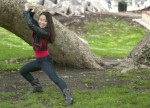On stage the armored comic book characters come to life, incorporating elements of gymnastics, acrobatics and martial arts. Sharp, controlled movements supply the base of the stage combat routine as second-year English student Yuuki Yamagiwa fights evil with high kicks and Kabuki sword techniques.
“When I was playing Sakura and my character was just about to be defeated by the monsters, there was a little girl in the front row who just screamed out my character’s name (in despair),” Yamagiwa said. “That is something I’ll remember for the rest of my life.”
Yamagiwa joined the “Fujiyama Ichiban” cast last July as Sakura, performing in live stage shows all across southern California to bring the Japanese comic book’s superhero characters to life. In addition to her extensive stage combat training, Yamagiwa infuses her role with skills she has acquired through her acting and dance experience.
Wilsa Derro, another stunt member in the “Fujiyama Ichiban” performances, said Yamagiwa is the only performer who shows her face. The rest of the cast is hidden behind elaborate armored masks, but Yamagiwa’s acting experience allows her to use her expressions and other techniques she’s learned to engage the audience.
“I call her the ringmaster because she is the face of the show. It’s like a switch, and when she turns it on, she goes full force interacting with the crowd,” Derro said.
Because Japanese stage combat derives from the tradition of kabuki, a staged dance-drama performance, Yamagiwa said she realized how acting and dance play a large part in the believability of and the audience’s investment in her performance.
Yamagiwa’s mentor, Michi Yamato, said performers must also take on the role of an actor. During performances like “Fujiyama Ichiban,” acting becomes the heart of stage combat, he said.
“As an actress, she has advantages over others when performing stage combat,” Yamato said. “She is good at adapting her part when she plays different characters.”
At 9 years old, Yamagiwa began learning stage combat techniques from her father, who was a professional stuntman in the TV show “Power Rangers.” Yamagiwa said he began teaching her and her sister when they were young girls – though she was often frustrated with the level of difficulty.
“I had the hardest time doing gymnastic techniques,” Yamagiwa said. “During summer break I used to go every day to the gym, but it was hard because I didn’t want to go so my body wasn’t working at the level it should have been.”
Although Yamagiwa had difficulty adhering to the rigorous training schedule, her persistence has paid off. She said she still has much gymnastics to learn, but she continues to learn to improve her stage combat skills.
Just as acting and gymnastics give Yamagiwa’s stage combat an edge, she said her work as a professional dancer also affects her performance. Derro said Yamagiwa’s jazz and ballet training are evident, and she possesses a high level of confidence.
“There are subtle details that make her movement look so professional,” Derro said. “She has full control over her body and she is very fluid.”
As she aspires toward a career in the performing arts, Yamagiwa said her versatility in stage combat, acting and dance is an asset in the film industry. Just as acting has helped Yamagiwa’s stage combat career, Yamato said stage combat will help Yamagiwa’s acting career.
Unlike many actors, Yamagiwa does not need stunt doubles to perform fight scenes, and she said her stage combat training has already begun to give her acting career an edge. She said her training gave her a more substantial role in the short film, “The Chronicles of the Order: Xander’s Path.”
“After the audition, when they found out I could perform my own fight scenes, they decided to extend my role and incorporate more fighting,” Yamagiwa said. “They decided to make the film longer, which was really cool.”
Email Komoto at kkomoto@media.ucla.edu.
